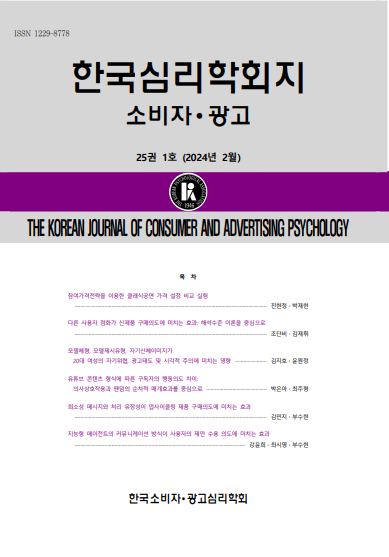open access
메뉴.png)
open access
메뉴 ISSN : 1229-8778
ISSN : 1229-8778
본 연구는 선호브랜드가 있음에도 불구하고 다른 브랜드와 긍정적인 상호작용(brand flirting)이 선호브랜드에 미치는 효과에 주목하여, 다른 브랜드와 긍정적인 상호작용을 했음에도 불구하고 선호브랜드에 긍정적인 효과를 이끌 수 있다는 기존 선행연구와는 달리 다른 브랜드와 긍정적인 상호작용이 빈번히 발생하는 소비자들의 구매상황에서 다른 브랜드의 경험은 기존 관계에 부정적 효과를 미칠 수 있음을 밝히고, 이를 막기 위한 방안을 모색하고자 하였다. 구매상황에서 다른 브랜드와 긍정적 상호작용 후, 예상된 만족을 평가하게 했을 경우 심상이미지가 활성화되어 이미지를 형성하기 쉬운 속성에 가중치를 두어 브랜드 전환이 감소할 수 있음을 예측하였다. 이를 검증하기 위해 총 2개의 연구를 진행하였다. 연구 1에서는 예상된 만족평가를 할 경우 플러팅 조건에 관계없이 선호브랜드 선택이 높았으나, 예상된 만족평가를 하지 않았을 경우 플러팅 유 조건이 무 조건에 비해 선호브랜드 선택이 감소하였다. 연구 2에서는 연구 1의 한계점을 보완하고 심상이미지 활성화의 효과를 보다 명확히 검증하기 위해 플러팅 상황에서 인지부하조건을 추가하여 실험을 진행하였다. 연구 2 결과, 예상된 만족평가를 할 경우 인지부하가 발생되었을 때 선호브랜드 선택이 감소 됨을 확인하였다. 반면, 예상된 만족평가를 하지 않은 경우 인지부하 조건과 관계없이 선호브랜드 선택이 낮게 나타났다. 본 연구의 결과는 구매상황에서는 다른 매력적인 브랜드를 경험했을 경우 브랜드 전환이 발생할 수 있으며, 예상된 만족평가를 통해 심상이미지 처리를 활성화시킴으로써 소비자의 브랜드 전환을 막을 수 있는 전략적 방안을 제안했다는 점에서 이론적, 실무적 의의를 가진다.
This research focused on the effect of positive interaction with other brands on the preferred brand, despite having a preferred brand. Unlike in previous studies that have focused only on the positive effect of preferred brand, the current research has the purpose to study (1) find out that brand flirting can negative effect existing relationships in the purchasing situation and (2) a strateagy to prevent its negative effect. In the purchase situation, when the anticipated satisfaction was evaluated befor the alternative choice after positive interaction with other brands, mental imagery was activated and the weight was placed on the attribute that is easy to form the image, and it was predicted that the brand switching could be reduced. In Study 1, when the anticipated satisfaction evaluation was performed, the choice of the preferred brand was high regardless of the flirting condition. But, whe the anticipated satisfaction evaluation was not performed, the choice of the preferred brand was decreased compared to the not flirting condition. In Study 2, in order to complement the limitations of Study 1 and to more clearly verify the mediating effect of mental imagery activation, an experiment was conducted by adding a cognitive load condition in a flirting situation. As a result of the study, it was confirmed that the choice of preferred brand decreased when cognitive load occurred when the anticipated satisfaction evaluation was performed. On the other hand, if the anticipated satisfaction evaluation was not performed, the preferred brand choice was low regardless of the cognitive load condition. The results of this research are meaningful in that a brand switching occurs when brand flirting in the purchasing situation, and a strategic plan to prevent brand switching is proposed by activated mental imagery through the anticipated satisfaction evaluation.
